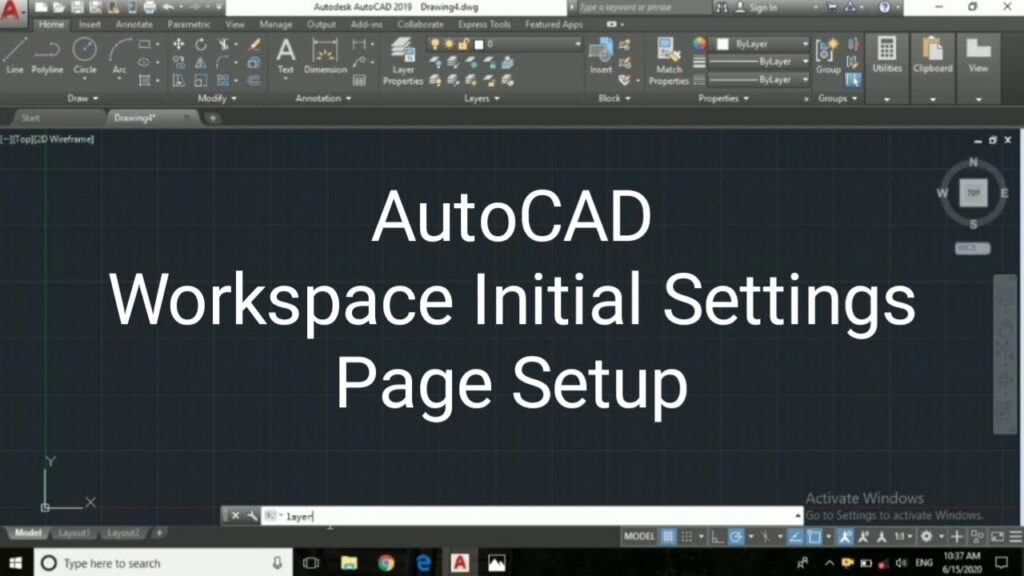A Comprehensive Guide: How to Set Up Your Workspace in AutoCAD

AutoCAD, developed by Autodesk, is a powerful computer-aided design (CAD) software application used by architects, engineers, designers, and drafters to create precise and detailed drawings and models. Setting up your workspace in AutoCAD is essential for optimizing your workflow and productivity, as it allows you to customize the interface, tools, and settings to suit your specific needs and preferences. In this comprehensive guide, we’ll walk you through the step-by-step process of setting up your workspace in AutoCAD, ensuring that you can work efficiently and effectively on your projects.
Step 1: Understanding the AutoCAD Interface
Before you begin customizing your workspace, it’s essential to familiarize yourself with the AutoCAD interface. The AutoCAD interface consists of various elements, including the Ribbon, Toolbars, Command Line, Model Space, and Layout Tabs. Understanding how these elements work together will help you navigate the software more efficiently and make informed decisions when customizing your workspace.
Step 2: Customize the Ribbon
The Ribbon is a key component of the AutoCAD interface, providing access to a wide range of tools and commands organized into tabs and panels. To customize the Ribbon, you can add, remove, or reorder tabs and panels to create a layout that aligns with your workflow. Right-clicking on the Ribbon allows you to access customization options, such as adding or removing tabs and panels, as well as creating custom tabs and panels with your favorite tools and commands.
Step 3: Configure Toolbars and Palettes
AutoCAD provides a variety of toolbars and palettes that allow you to access additional tools and commands quickly. To customize toolbars and palettes, you can right-click on any toolbar or palette to access customization options, such as adding or removing tools, changing the display style, or docking the toolbar or palette to a specific location in the interface. You can also create custom tool palettes with your frequently used blocks, hatches, and other content.
Step 4: Organize the Command Line
The Command Line is a powerful tool in AutoCAD that allows you to enter commands and options directly. You can customize the Command Line by adjusting its size, position, and behavior to suit your preferences. To customize the Command Line, right-click on it and select options such as changing the text size, enabling or disabling dynamic input, and displaying recent commands.
Step 5: Customize Model Space and Layout Tabs
In AutoCAD, you can work in both Model Space and Layout Tabs to create and organize your drawings. Model Space is where you create your drawing geometry, while Layout Tabs allow you to set up multiple layout views for printing and presentation. To customize Model Space and Layout Tabs, you can adjust their display settings, add or remove tabs, and configure the viewport layout to suit your specific needs.
Step 6: Save Your Workspace
Once you’ve customized your workspace to your liking, it’s essential to save your settings to ensure that they are preserved for future use. To save your workspace in AutoCAD, you can use the “Save As” command to create a custom workspace file (.cui) that contains your customized interface settings. You can then load this workspace file whenever you start AutoCAD to quickly restore your customized workspace layout.
Step 7: Experiment and Adjust
Setting up your workspace in AutoCAD is an iterative process, and it’s essential to experiment with different layouts, configurations, and settings to find what works best for you. Don’t be afraid to try new things and make adjustments as needed to optimize your workflow and productivity. Remember that your workspace is a reflection of your unique workflow and preferences, so feel free to tailor it to suit your specific needs.
In conclusion, setting up your workspace in AutoCAD is a crucial step in optimizing your workflow and productivity. By customizing the interface, tools, and settings to suit your specific needs and preferences, you can work more efficiently and effectively on your projects. By following this comprehensive guide, you can create a customized workspace in AutoCAD that empowers you to unleash your creativity and achieve your design goals with precision and ease.




